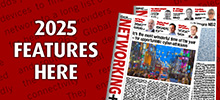20 July 2023
Martin Hodgson, regional sales manager, Northern Europe, Paessler AG
Nevertheless, a challenge arises when outdated machinery on the factory floor lacks the necessary components for data collection or when an office building has an archaic IT infrastructure. For example, it may lack the required connectivity, data interfaces, and data points to support modern data-gathering scenarios.
To overcome this obstacle, retrofitting emerges as a solution because it breathes new life into ageing machines or lighting, air conditioning and heating infrastructure in buildings, equipping them with intelligent capabilities by enhancing their connectivity. A prevalent method employed in this process is the integration of IIoT sensors onto older machines. This integration empowers the machines to collect vital information regarding their status, condition, and operations, enabling the transmission of this data to other systems for further analysis and processing.
So, in a world where new solutions are being innovated every day, how can businesses retrofit their operations to keep up with the times and run an efficient company? Here are five of the myths around retrofitting and how to get started.
Myth #1: It’s too expensive
Tip: The cost-saving benefits behind retrofitting: the practice of making expensive legacy equipment compatible with machines that use modern IT is where the beauty of retrofitting comes into play. By equipping the machines with additional sensors to gather data for IIoT applications like condition monitoring or predictive maintenance is a trend which has grown tremendously as companies look to harness data intelligence to improve and optimise certain processes without breaking the bank.
Myth #2: It’s too complex to implement
Tip: Examine, process and analyse your infrastructure: when undertaking a retrofitting project, it entails the integration of new machinery, sensors, gateways, and other communication devices into the existing industrial network. To make the whole process as simple as possible, it is essential to have a clear understanding of the capabilities of your current network infrastructure. This involves assessing the performance and capacity of your industrial networking hardware, such as routers and switches, and considering any bandwidth limitations that may exist to iron out any potential problems before they arise.
Myth #3: There isn’t sufficient data
Tip: Take inventory of the data you actually need: the best way to start is to work backwards and write down all the data you need to track, and then analyse the machinery and equipment in place to know where the gaps are when it comes to data monitoring.
Quite often IT and facilities managers are surprised by how much data is at their fingertips, it’s just a question of joining up the dots before and during the retrofit process. Quite often there are a lot of different types of data that need to be collected and analysed about the IT and OT infrastructure that they need a monitoring tool that is able to bring in data from IIoT sensors, OT systems, and traditional IT components.
Myth #4: You don’t need to monitor the data centre environment
Tip: Environmental monitoring isn’t just necessary – it's essential: in order to future-proof a building, its hardware and machinery are important aspects of the retrofit process to monitor the environment such as humidity, temperature and air conditioning. This is an essential practice to protect data centres, servers, hardware and prevent downtime, fire hazards or unexpected and costly repairs.
It’s also necessary to monitor the data centre environment because of potential security risks including unauthorised intrusions by individuals. Ensuring effective data protection requires implementing digital safeguards to create a protective barrier that deters hackers from manipulating the data. Additionally, during the retrofit process securing the physical infrastructure involves employing door lock systems, installing alarm systems, the utilisation of cameras, motion sensors, and even heat sensors becomes crucial as well as setting up alerts to promptly respond to any breaches.
Myth #5: There are too many software options available
Tip: Implementing holistic network monitoring should be seen as part of an overall business strategy: while the addition of sensors to machines during a retrofit is undoubtedly crucial, it represents just one aspect of the broader picture. To derive meaningful insights and make informed decisions, it is equally essential to effectively analyse the data collected by these sensors and convert it into actionable information. Such a process necessitates the utilisation of a well-suited software solution tailored to the specific monitoring needs of the network.
Businesses can maximise the value of their networking monitoring efforts by utilising cutting-edge software tools. This will allow them to proactively identify and resolve potential issues, optimise performance, and boost overall operational effectiveness. As well as enabling organisations to make data-driven decisions, this strategic approach ensures competitive advantage in an increasingly oversaturated market.










